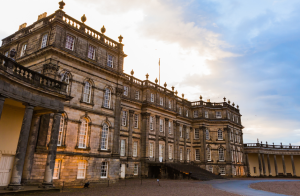From Abercorn lands to tranquil woodland and lawns: a brief history of the Hopetoun Grounds.

Up until the 1670s, the land where Hopetoun House now stands was known as the lands of Abercorn. The site boasted spectacular views down to Berwick Law and over the parish of Abercorn. In 1678, John Hope purchased the land and named it Hopetoun.
The site for Hopetoun House was selected well, elevated enough for good views, but not too exposed. When work on the Grounds began, Charles Hope (later the 1st Earl) was still a minor and his mother, following the death of John Hope, was advised principally by Alexander Edward, a former Presbyterian Minister with a great interest and talent for garden design, and by the architect Sir William Bruce. William Bruce was one of the first architects to emphasise the relationship between house, gardens and landscape.
Bruce would also have designed the Kitchen Garden and Grounds, or supervised their design. The House and immediate surroundings, including the vistas, must date from the very earliest days of building as there was a considerable amount of earth works and landscaping that would have been required before the House build began. Part of Bruce’s vision included a parterre (a knee high hedge) or formal garden on the West Lawns. Bruce also designed the Round Pond behind the parterre. This was added in order to reflect the House and continue his theme of symmetry.
As the Grounds were gradually planted and landscaped, they were transformed from a flat expanse of moor into a wooded haven for wildlife. In one year alone, gardeners and groundsmen planted an incredible 1,800 Holly trees, 12,000 thorn trees and 6,000 Beech trees. The impressive Yew hedge that runs along the top of the North Deer Park is one of the many features you can see today, dating from the 1700s.
The woodland at Hopetoun is particularly interesting because growing here, amongst our native trees, are some exotic foreigners. In the 1800s intrepid botanists travelled to some of the most remote and dangerous parts of the world in search of unknown plants to bring back to Britain. The Grounds of Hopetoun reflect the fashion for collecting these new flora.
Then, not far into the 18th century, formality, symmetry and artifice fell victim to an emerging taste for naturalistic features and planting that culminated in the English Landscape Style.
The 1st Earl commissioned the remodelling and extension of the house in 1720. William Adam’s survey was completed around that year, which would reflect these changes in design.
The 2nd Earl of Hopetoun, John Hope, commissioned William Adam to extend the House and make some changes to the Grounds. Adam removed the parterre to create the West Lawns. The fountain or “Jet du” was also added to the Round Pond. Adam also re-organised the gardens and created the Spring Garden and the Dial Park.
Today, these 100 acres of designed landscape are the perfect place to escape to nature, explore the trails and look out for the local wildlife. From quiet woodland corners to the beautiful Spring Garden, there is something to look out for throughout the year.
The Grounds of Hopetoun to this day are still maintained by an inhouse grounds care team and the mature biodiversity is cared for by the Hopetoun House Ranger Service to ensure its sustainability.
You can download the Hopetoun Grounds Map to help you plan your visit and find your way around the Grounds using the Spring Garden Trail and Sea Walk Trail.
Categories: Hopetoun House


